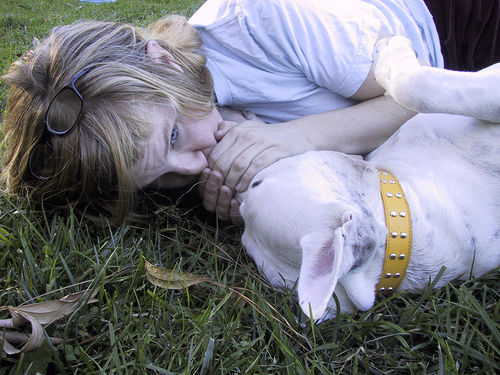What do you do if your dog stops breathing? Is CPR an option?
Yes, CPR is a very real solution. We know of one dog that was successfully brought back to life after her heart and respiration stopped from smoke inhalation in a house fire. The procedure is different then the procedure used in resuscitating humans and the worst time to learn CPR is when you need to perform it. An excellent source for becoming familiar with the procedure is Ruff Wear's Quick Guide to Animal Emergencies.
Yes, CPR is a very real solution. We know of one dog that was successfully brought back to life after her heart and respiration stopped from smoke inhalation in a house fire. The procedure is different then the procedure used in resuscitating humans and the worst time to learn CPR is when you need to perform it. An excellent source for becoming familiar with the procedure is Ruff Wear's Quick Guide to Animal Emergencies.
What do you do if your dog is choking?
It is best to learn and know the proper sequence in which to respond to a choking incident before the actual event. Familiarize yourself by reading a quality pet first aid guide to be prepared before the need arises. Performing the Heimlich is a good option but only once you have ruled out the possibility of a foreign object lodged in the throat that may be accessed and removed through the mouth. Again there is no substitute for a good pet first aid guide to provide you with a step-by-step procedure
It is best to learn and know the proper sequence in which to respond to a choking incident before the actual event. Familiarize yourself by reading a quality pet first aid guide to be prepared before the need arises. Performing the Heimlich is a good option but only once you have ruled out the possibility of a foreign object lodged in the throat that may be accessed and removed through the mouth. Again there is no substitute for a good pet first aid guide to provide you with a step-by-step procedure
What's the best way to remove a tick from a dog?
Wearing gloves you should grasp the entire tick with tweezers and remove the complete tick by holding firmly and pulling gently, making certain to remove all the mouthparts. You may want to save the tick for identification by your vet to confirm if the tick carries any diseases. Apply a disinfectant or antibiotic ointment to the bite.
Wearing gloves you should grasp the entire tick with tweezers and remove the complete tick by holding firmly and pulling gently, making certain to remove all the mouthparts. You may want to save the tick for identification by your vet to confirm if the tick carries any diseases. Apply a disinfectant or antibiotic ointment to the bite.
How can you calm an injured dog?
Even if the dog is your best buddy, always approach an injured dog with caution. Assess the situation and consider a muzzle to restrain a pet that is in pain and possible shock. A traumatized pet will often snap or bite. In more extreme conditions a blanket may be dropped over the animal until a muzzle can be applied. Dogs are very intuitive so any panic or cause for alarm by the caregiver will raise the fear factor for the pet. By remaining calm and being prepared you will be able to reassure the animal and not cause additional anxiety.
Even if the dog is your best buddy, always approach an injured dog with caution. Assess the situation and consider a muzzle to restrain a pet that is in pain and possible shock. A traumatized pet will often snap or bite. In more extreme conditions a blanket may be dropped over the animal until a muzzle can be applied. Dogs are very intuitive so any panic or cause for alarm by the caregiver will raise the fear factor for the pet. By remaining calm and being prepared you will be able to reassure the animal and not cause additional anxiety.
It's up to you!
The best way to reduce the possibility of a pet sustaining an injury is prevention. Be aware of your surroundings and potentially hazardous plants and animals with which your dog may come in contact. Be prepared with a first aid kit that matches the duration of your time away from immediate assistance as well as your exposure to the elements. Remember, the worst time to learn about assisting an injured pet is when your dog sustains an injury. Become familiar with the kit and the information provided so that you will know how you may assist before the need arises.
The best way to reduce the possibility of a pet sustaining an injury is prevention. Be aware of your surroundings and potentially hazardous plants and animals with which your dog may come in contact. Be prepared with a first aid kit that matches the duration of your time away from immediate assistance as well as your exposure to the elements. Remember, the worst time to learn about assisting an injured pet is when your dog sustains an injury. Become familiar with the kit and the information provided so that you will know how you may assist before the need arises.
Powered by http://www.scruffmacduff.co.uk
Performance Outdoor Gear for Dogs

No comments:
Post a Comment